Microsoft ends support for Internet Explorer on June 16, 2022.
We recommend using one of the browsers listed below.
- Microsoft Edge(Latest version)
- Mozilla Firefox(Latest version)
- Google Chrome(Latest version)
- Apple Safari(Latest version)
Please contact your browser provider for download and installation instructions.
November 25, 2020
Nippon Telegraph and Telephone Corporation
Nagoya University
Hokkaido University
Neutron energy dependence of semiconductor soft errors was successfully measured for the first time
– Enabling calculation of the number of soft errors caused by neutrons in various environments, e.g., in outer space or even on other planets &nda
Nippon Telegraph and Telephone Corporation (Head Office: Chiyoda-ku, Tokyo; President and CEO: Jun Sawada), Nagoya University (Nagoya-shi, Aichi; President: Seiichi Matsuo), and Hokkaido University (Sapporo-shi, Hokkaido; President: Kiyohiro Houkin) joined forces and successfully measured semiconductor soft error(*1) rates(*2) at continuously varying neutron energies from 1MeV to 800MeV. The findings reveal, for the first time, the complete picture of the energy dependence of semiconductor soft errors.
Data on soft error rate dependence on neutron energy are critical when studying the impact of cosmic rays on semiconductors and investigating countermeasures because the number of soft errors is heavily dependent on the incoming neutron energy. However, it has been impossible to measure data that have a wide and continuous energy range. Therefore, the soft error rates measured to date have been limited to several discrete neutron energy levels.
We have developed an ultra-high-speed error detection circuit that enables us to precisely measure flight times of neutrons arriving at the semiconductor even if the velocities are close to the speed of light. From the flight time we can deduce the speed of the neutrons causing the soft errors. The circuit makes it possible to measure soft errors caused by neutrons across an extremely wide range of energies up to 800 MeV.
Soft error rates, which we measured successfully, are among the most basic and critical data to predict the number of soft errors caused by neutrons in various environments not only at ground level but also at high altitudes, in space, or even on another planet. The data will be useful in a variety of fields: evaluation of semiconductor reliability in space stations, study of soft error prevention measures to be taken in semiconductor materials, soft error tests using an accelerator, and simulation of the process in which soft errors occur.
The research results were published in IEEE Transactions on Nuclear Science on November 19, 2020.
[IEEE Transactions on Nuclear Science] https://ieeexplore.ieee.org/document/9201514
[Video - long version] https://youtu.be/mhQmhzj6Zcg/
[Video - short version]https://youtu.be/GJvvXMcR3D4/
1. Background
Today, sophisticated electronic devices support our lives in numerous ways, but they increasingly fall victim to soft errors caused by cosmic rays. When cosmic rays, which pour down from space, collide with oxygen or nitrogen atoms in the atmosphere, neutrons are emitted. When neutrons collide with a semiconductor in an electronic device, they can cause "soft errors," a phenomenon whereby the data stored in a semiconductor are changed. Soft errors have the potential to impact social infrastructures in seriously adverse ways (Fig. 1).
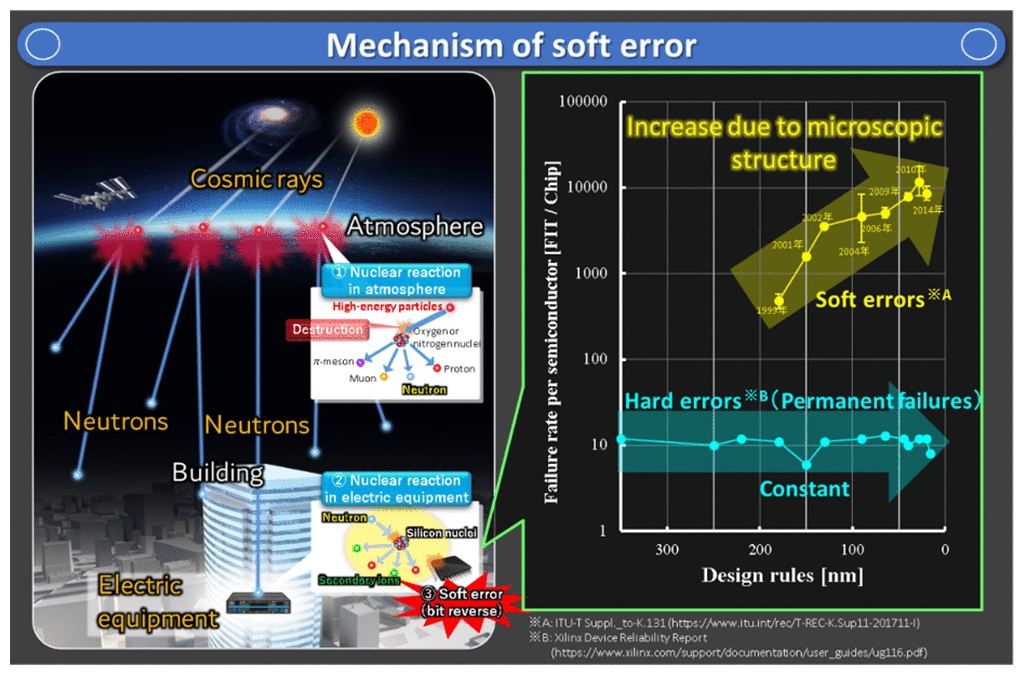 Fig. 1 Mechanism of soft error
Fig. 1 Mechanism of soft error
Today, various measures are taken to ensure stable operation of social infrastructures, such as error prevention measures within electronic devices and redundancy in equipment and systems. However, in the future, as high integration and miniaturization of semiconductors advance, electronic devices will be increasingly affected by neutrons. Therefore, it will become ever more important to design semiconductors and systems to reduce the number of failures caused by soft errors per unit time. If we are to calculate the number of failures caused by soft errors in a variety of environments, it is essential to have detailed data on the neutron-energy-dependent soft error rate.
The soft error rate varies depending on the neutron energy level. The neutrons flying in an environment have an energy distribution that varies from place to place, e.g., on earth, in outer space or on other planets. Therefore, to determine the number of failures caused by soft errors, it is necessary to take the number of neutrons at a given energy in each type of environment into consideration. This is calculated as follows:
- Let the number of neutrons at energy E be φ(E).
- Multiply this by the neutron-energy E dependent soft error rate σ(E) .
- The number of failures caused by neutrons at energy E can be calculated by φ(E) × σ(E) .
The total number of failures caused by soft errors at a given place or environment can be obtained as in Eq. (1) by integrated over or summing up the number of failures ((iii) above) with all the energy E distributed in the environment.

In this way, the data on the neutron-energy-dependent soft error rate ( in (ii) above) is essential for calculating the number of failures caused by soft errors.
However, conventionally, soft error rates have been measured only for discrete energies using an accelerator. Consequently, soft error rates could only be obtained at discrete energies, as shown in Fig. 3. This has made accurate calculation of the number of failures caused by soft errors extremely difficult. If we are to calculate the number of failures accurately, we need data on soft error rates measured at continuously varying neutron energies, but such measurement has been considered impossible. To solve this problem, NTT has been studying a measurement method that focuses on neutron speed.
-
 Fig. 3 Conventional technology (soft error rate measurement results)
Fig. 3 Conventional technology (soft error rate measurement results)
-
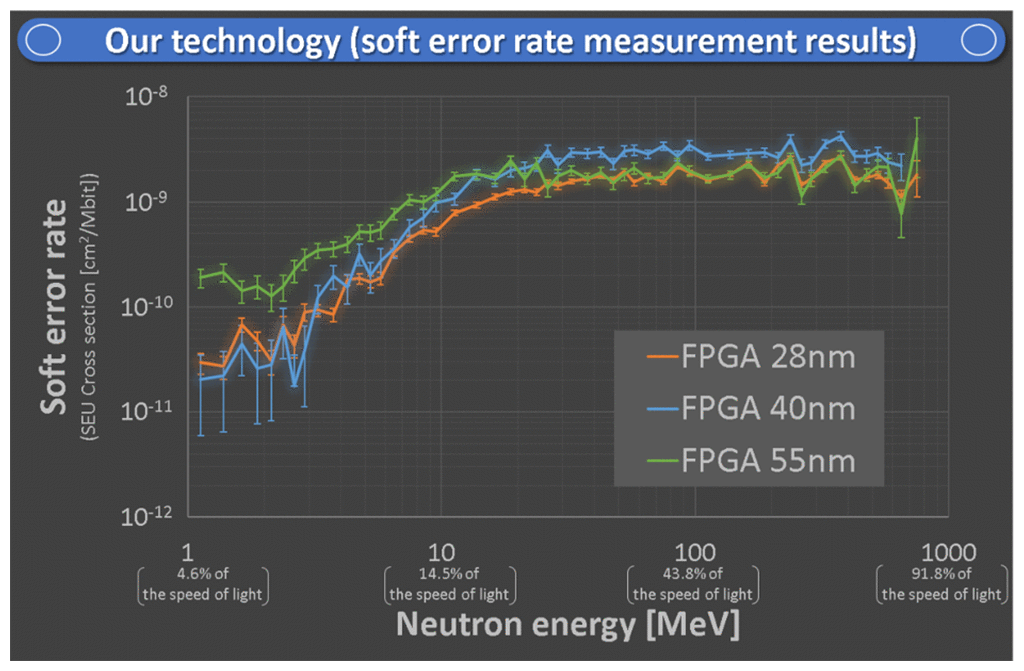 Fig. 4 Our technology (soft error rate measurement results)
Fig. 4 Our technology (soft error rate measurement results)
2. Research results
In this research, we have developed a high-speed error detection circuit that can detect soft errors within several nanoseconds (nano = one billionth) so that we can identify the energy of a neutron close to the speed of light using a time-of-flight method. By this method, measuring the traveling time of a neutron from a neutron production target to a device, we can calculate the velocity of the neutron and hence its energy. Using the 800-MeV high energy proton linear accelerator at Los Alamos National Laboratory, we conducted experiments with three FPGAs(*3) with different design rules: 28 nm, 40 nm and 55 nm. We were able to measure soft error rates at continuous energies with very high energy resolution, as shown in Fig. 4.
It was found that the energy dependence of soft error rates was more or less similar for the three FPGAs. The soft error rate increases rapidly from 3 MeV to 20 MeV, but is almost constant thereafter, although upon closer examination slight variations in the rate among the three FPGAs were found.
3. Key technical points
3-1. Time-of-flight method
(Kinetic) energy E of a neutron can be determined by measuring the neutron speed, i.e., time it takes for a neutron to travel a certain distance. It is expressed by Eq. (2) based on the special theory of relativity using the energy of the neutron having the speed v and the rest mass m0, where c is the light speed.

In our experiments, neutrons were generated within an extremely short time of 125 picoseconds (picosecond = one trillionth of a second), and the time taken for them to fly about 20 meters was measured. This made it possible to measure the energy of a neutron traveling at a speed close to that of light (Fig. 5). The relationship between the time of flight of a neutron traveling a distance of 20 meters and the neutron energy is shown in Fig. 6.
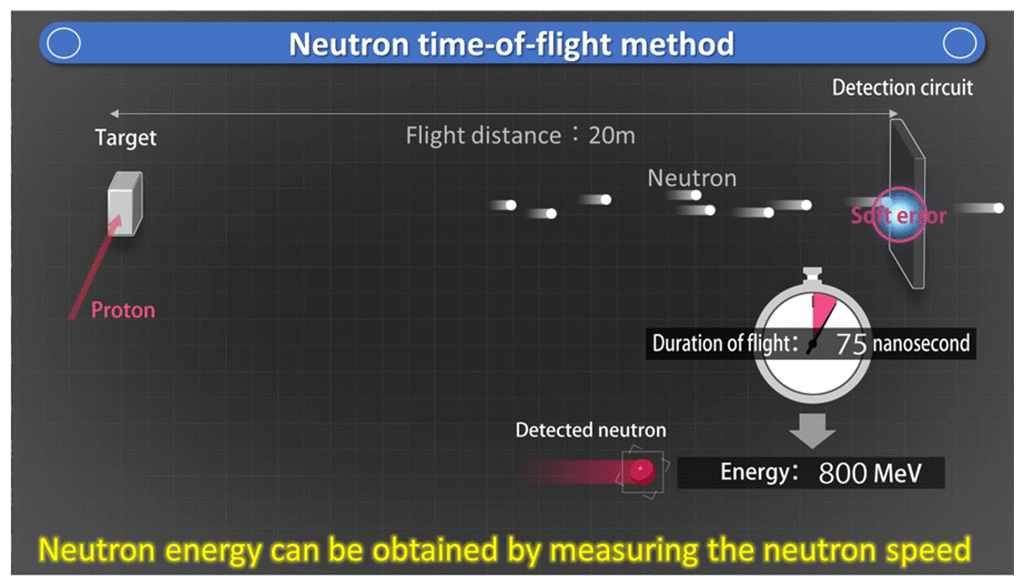 Fig. 5 Neutron time-of-flight method
Fig. 5 Neutron time-of-flight method
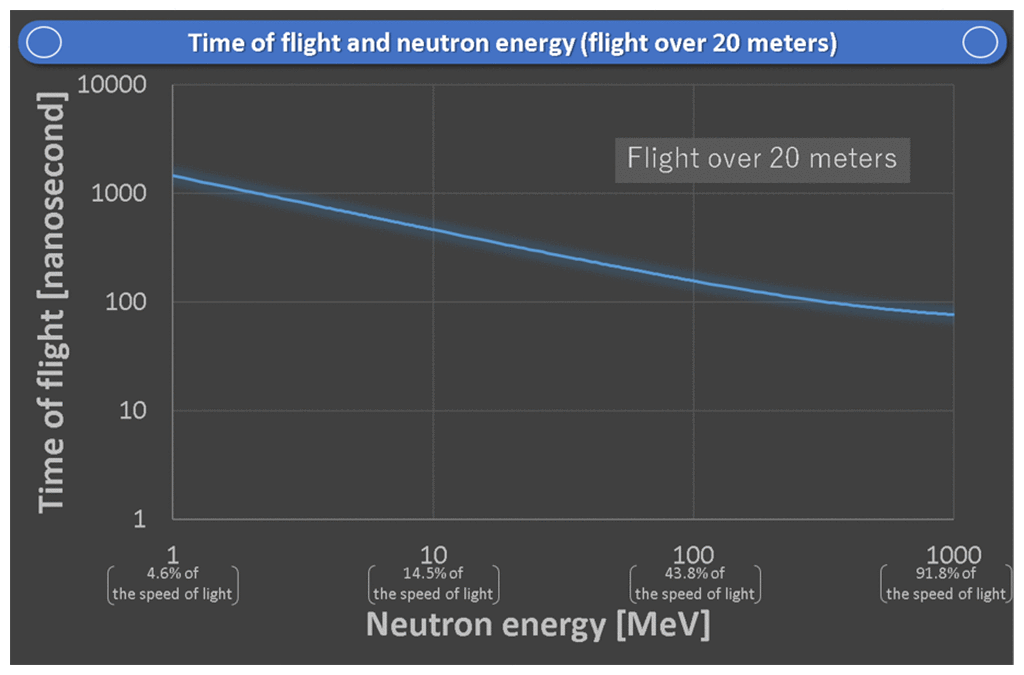 Fig. 6 Time of flight and neutron energy (flight over 20 meters)
Fig. 6 Time of flight and neutron energy (flight over 20 meters)
3-2. Ultra-high-speed error detection circuit (NTT, Nagoya University, and Hokkaido University)
As shown in Fig. 6, neutrons that cause soft errors are traveling at extremely high speed. To measure their energies, it is necessary to detect soft errors at nanosecond resolution. However, commonly used memories such as static random access memory (SRAM) read data sequentially and thus take several milliseconds to scan the amount of data (megabit order) sufficient for soft error detection. This means that the time-of-flight method cannot be used in this memory to determine the energy of high energy neutrons. To solve this problem, we have developed a circuit that can detect malfunctions caused by soft errors in logic circuits with extraordinary speed (Fig. 7). By using this system, we were able to detect a soft error that occurred to CRAMs(*4).Each CRAM had a capacity of a few tens of megabits and the CRAMs made up an FPGA circuit. The circuit can detect a soft error at a speed equivalent to the operational speed of the FPGA, which is in the order of nano seconds. By using this high-speed error detection circuit, in a world first, we can now identify the energy of neutrons that cause soft errors.
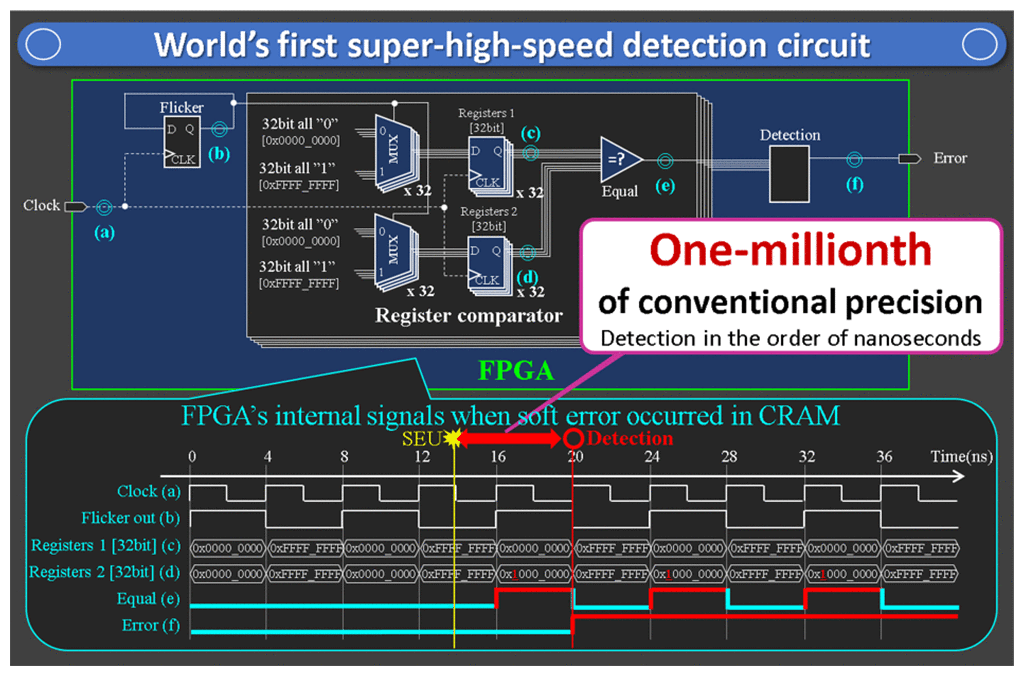 Fig. 7 High-speed error detection circuit
Fig. 7 High-speed error detection circuit
3-3. The 800-MeV high energy proton accelerator at Los Alamos National Laboratory
Using the high energy accelerator at Los Alamos National Laboratory (Fig. 8), we conducted experiments in which we measured soft error rates at continuous energies using the newly developed ultra-high-speed error detection circuit explained above. The accelerator accelerates protons up to 800 MeV, which is about 90% of the speed of light, and they hit the tungsten target and generate high energy neutrons. The energy distribution of neutrons thus generated with the facility is similar to that in nature of up to 800 MeV (Fig. 9). In this facility, a neutron detector, called a "fission chamber," has been used to measure the energy spectrum(*5) of the neutrons up to 800 MeV.
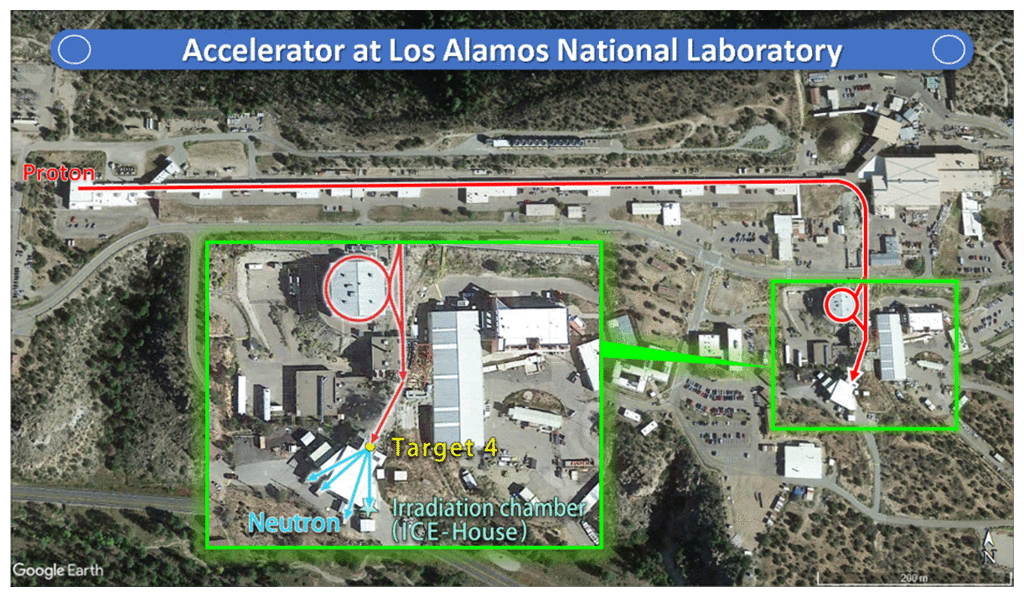 Fig. 8 Accelerator at Los Alamos National Laboratory
Fig. 8 Accelerator at Los Alamos National Laboratory
4. Future prospects
The data obtained enable us to calculate the number of soft errors caused by neutrons in any environment, not only on earth but also at high altitudes, in space or even on another planet. In addition, the data will be useful for selection of an optimal accelerator for soft error tests, development of neutron sources for soft error tests, studies of measures to prevent soft errors in semiconductor devices, and simulation of the process in which soft errors occur. The data have the potential to lead to dramatic advances in research and development in a variety of fields.
5. Information about the paper
| Publication: | IEEE Transaction on Nuclear Science |
|---|---|
| Paper title: | Energy-resolved Soft-Error Rate Measurements for 1-800 MeV Neutrons by the Time-of-flight Technique at LANSCE |
| Authors: | Hidenori Iwashita, Gentaro Funatsu, Hirotaka Sato, Takashi Kamiyama, Michihiro Furusaka, Stephen A. Wender, Eric Pitcher, and Yoshiaki Kiyanagi |
| DOI: | 10.1109/TNS.2020.3025727 |
Glossary
- soft error:
Unlike hard errors, which cause permanent failures in a device, soft errors cause temporary failures, from which the device concerned can recover by rebooting itself or overwriting data. - soft error rate:
The probability at which one neutron causes a soft error in a unit area. In more technical terms, it is defined as a single event upset (SEU) cross section or it is sometimes defined as the probability at which a soft error occurs within a unit time. - FPGA:
A field programmable gate array (FPGA) is a logic device with which the user can program a logic circuit in the field. - CRAM:
A configuration memory (CRAM) is a logic element in an FPGA and determines connecting elements. If a soft error occurs in this memory, its logic and connections change immediately from the ones intended by the user and the memory operates abnormally. - neutron energy spectrum:
This is the neutron flux distribution for different neutron energies. The neutron flux is the number of neutrons that pass through a unit area within a unit time.
Attachment: reference materials
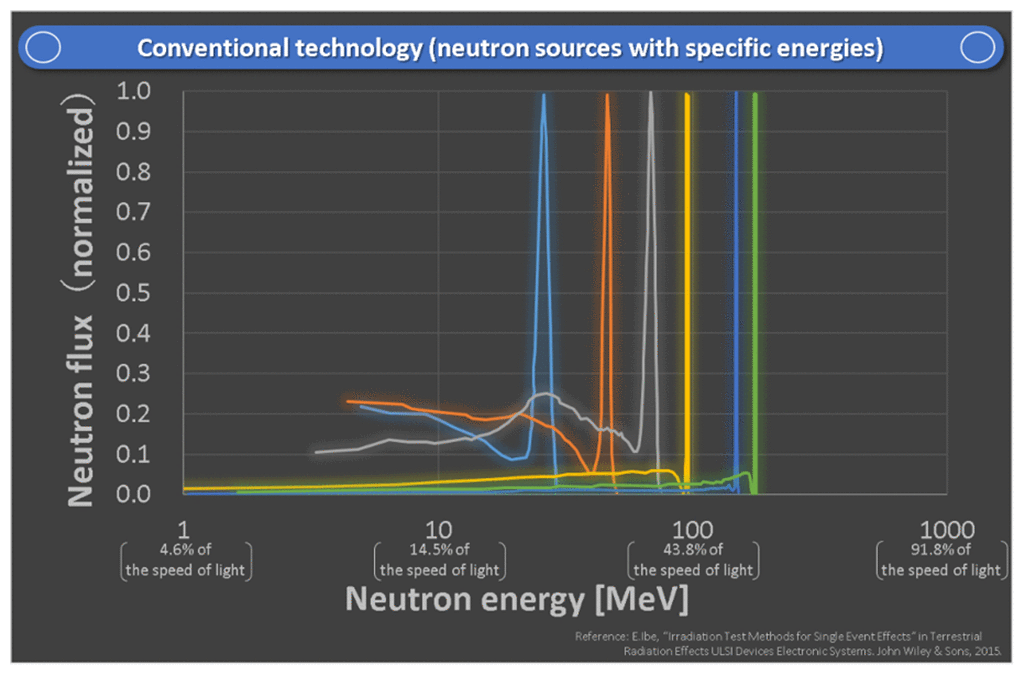 Fig. 2 Conventional technology (neutron sources with specific energies)
Fig. 2 Conventional technology (neutron sources with specific energies)
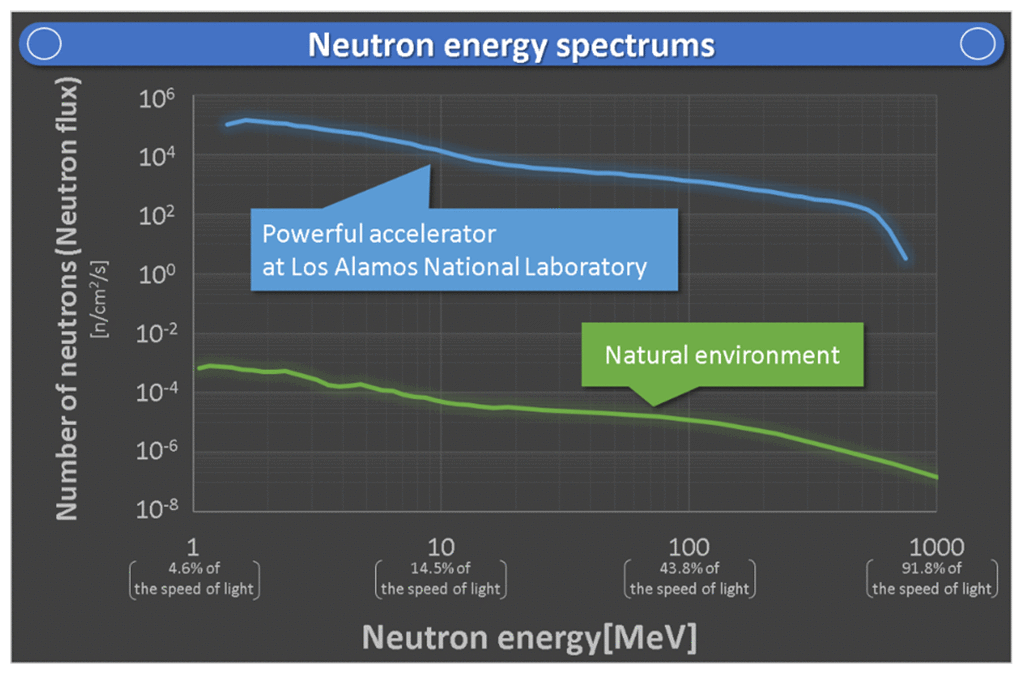 Fig. 9 Neutron energy spectrum obtained at Los Alamos National Laboratory
Fig. 9 Neutron energy spectrum obtained at Los Alamos National Laboratory
Contact Information
Nippon Telegraph and Telephone Corporation
Public Relations Section, Planning Department
Information Network Laboratory Group
E-mail: inlg-pr-pb-ml@hco.ntt.co.jp
Nagoya University
<1>Inquiries regarding this research
Research Laboratory of Accelerator-based BNCT System, Graduate School of Engineering
Designated Professor Yoshiaki Kiyanagi
Email: kiyanagi@phi.phys.nagoya-u.ac.jp
<2>Media-related inquiries
Public Relations Section, General Affairs Division, Nagoya University
Email: nu_research@adm.nagoya-u.ac.jp
Hokkaido University
<1>Inquiries regarding this research
Applied Quantum Science and Engineering, Faculty of Engineering
Professor Takashi Kamiyama
Email: takashik@eng.hokudai.ac.jp
Associate Professor Hirotaka Sato
Email: h.sato@eng.hokudai.ac.jp
Professor Michihiro Furusaka
Email: furusaka@eng.hokudai.ac.jp
<2>Media-related inquiries
Public Relations Division, General Affairs and Planning Department, Hokkaido University
Email: en-press@general.hokudai.ac.jp
Information is current as of the date of issue of the individual press release.
Please be advised that information may be outdated after that point.
NTT STORY
WEB media that thinks about the future with NTT









